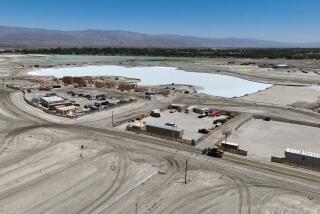Desert Burg Looking Like a Hot Property Again
- Share via
AMBOY, Calif. (Pop. 7) — It’s the quintessential tiny desert town half pitched to nowhere on legendary Route 66, and it’s about to be sold. Again.
The 690-acre real estate package includes the 150-acre town, a 1940s-style cafe, four operational gas pumps, a post office, a church, 28 motel rooms, public restrooms and two dirt runways, all framed by stark volcanic mountain ranges and barren vistas about 150 miles east of Los Angeles.
After a year and a half on the market, the whole thing may go for roughly $1,395,000, according to Rob McManus, estate director for Dilbeck Realtors, who is brokering the deal for the town owned by celebrity photographer Timothy White and his business partner, Walt Wilson.
White and Wilson, who bought the San Bernardino County burg for an undisclosed amount five years ago, originally listed it in July at $1.9 million.
But top bids failed to break the million-dollar mark -- perhaps, McManus said, because the nation went to war in the middle of a marketing campaign that featured advertising brochures, magazine articles, newspaper listings and an EBay online auction.
Prospects brightened this month with the arrival of separate offers by Californians who say they want to preserve the town that McManus described as “a charming relic, straight out of the 1940s and in good working condition.”
“I’m not allowed to reveal much information about the negotiations, other than that the terms and conditions should work,” he said. “But it’s going to be interesting drawing up an appropriate contract because there is no template for this kind of transaction.”
In a telephone interview from his New York studio, White said, “I’m very excited.”
“But while we’re ready to move on and turn it over to another caretaker,” he said, “it’s kind of tough, because we’re emotionally involved in this property. It’s a very spiritual place, and a piece of American history.”
Founded by miners in 1858, Amboy blossomed into a rowdy 24-hour town of 500 people when Route 66 was paved in the 1920s. The construction of Interstate 40 about 10 miles north in 1972, however, reduced traffic in the hamlet to a trickle. Amboy became a symbol of a bygone era and, as real estate agents like to say, “a town at the threshold of potential.”
These days, it survives as a tourist stop between Palm Springs and Las Vegas -- a stretch of about 180 miles -- and a popular locale for movies, commercials and photo shoots.
White, 48, was on a motorcycle trip when he first saw Amboy.
“I was captivated by the light, the location, the peeling paint, the stainless steel cafe interior, the old-fashioned gas pumps. It seemed as though time had stopped in 1951,” he recalled. “Then I noticed the 4-foot-by-5-foot hand-painted ‘For Sale’ sign. We didn’t want anyone else to ruin the place, so we bought it.”
“I feel real good about the new offers,” he added, “because I think they are serious and their intentions are the same as ours. We didn’t want it bastardized or modernized.”
Meanwhile, Wilson, 51, Amboy resident and the town’s general manager, keeps busy fixing up his motel rooms and grilling hamburgers, hot dogs and BLTs at Roy’s Cafe, a Route 66 landmark.
“It doesn’t get too lonely,” he said. “After all, Las Vegas is not that far away.”
More to Read
Sign up for Essential California
The most important California stories and recommendations in your inbox every morning.
You may occasionally receive promotional content from the Los Angeles Times.











